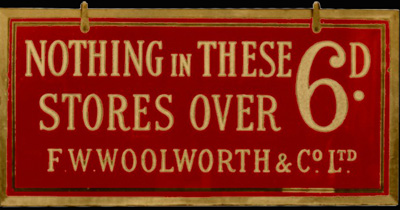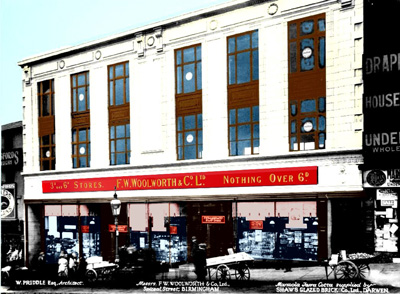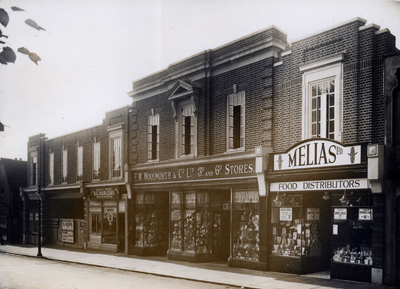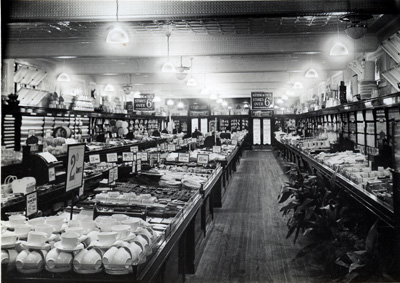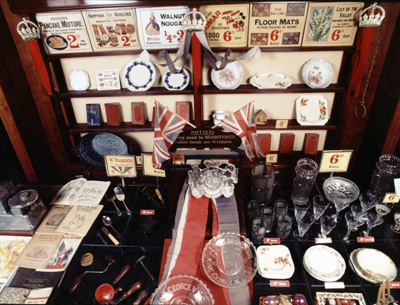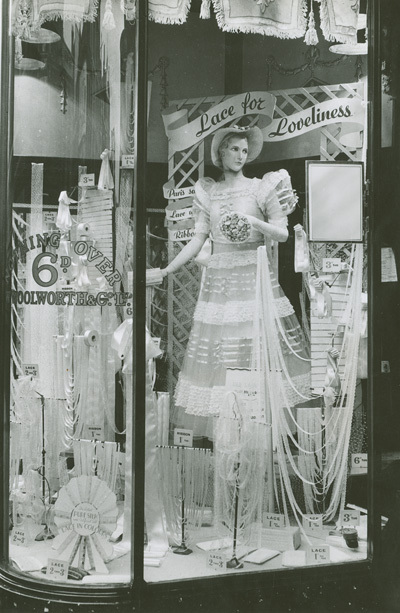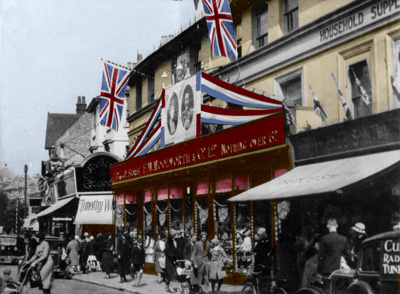Remembering the Thirties
when nothing at Woolworth's was over sixpence
In the 1930s Woolies was famous for the motto of 'Nothing over Sixpence'
or 'Nix over Six'. The chain expanded rapidly, building up to 767 stores between
1909 and 1939, of which more than four hundred branches were opened
during the Thirties, many at the height of the Great Depression.
The firm's huge buying power, coupled with the expertise of their people,
allowed them to offer decently-made no-frills British items at a fraction of
the price elsewhere.
Nothing over Sixpence signs like this one were factory made by
a process which sandblasted maroon paint onto a sheet of glass, and,
after that coat had tried, a further coat of gold paint through a stencil.
They appeared at the front, middle and back of every aisle in every
one of a growing chain and threepenny and sixpenny stores.
The Nothing over Sixpence message wasn't just inside the store.
It featured prominently on the fascia above the front doors, and
in the windows too. The store pictured, which was one of the firm's
most successful, dominated Birmingham's Bull Ring for more than
sity years, from its position in Spiceal Street. The property was
extended in the Sixties to form a key part of the glass and concerete
Bull Ring Shopping Centre, before being sold for redevelopment in 1983.
Today Selfridges of Birmingham stands on this spot, with their unique
store of architectural significance.
By way of comparison, here's a picture of a typical smaller Woolies,
one of more than four hundred that opened in the 1930s. The store
is Maldon, Essex, which opened on 6 June 1932. Woolworts relocated
in the town in the 1970s, with WHSmith taking over these premises,
where they still trade today.
Stepping inside the Maldon store, here are the displays ready for the opening.
The counters were made of the finest mahogany, laid out into islands
in the middle of the floor, each offering personal service and its own tills.
Goods were displayed on a single level, arranged by department and
placed between glass dividers on the top of the counters. Each item
had a large sign stating its price, rather than being priced individually,
even when everything in the range was sixpence! Sixpence then would
be £2.11 or $3.60 today. The layout of every Woolworths, large or
small, followed this pattern, with the display standard strictly enforced
by Superintendents (fearsome travelling Area Managers) who visited regularly.
In the early 1950s, as work continued to rebuild London after the Blitz,
Woolworths assembled an exhibit of products and counters from a
pre-war store to appear in the new Museum of London in the Barbican.
It includes a wooden cash register, a sandblasted 'Nothing in these Stores
over Sixpence sign'. mahogany counters and an assortment of products.
The picture is Copyright to the Museum of London, whose permission
would be needed before reproducing it. They have others in the same series.
Another important part of the Woolworths brand was the elegant display
windows, which were changed twice a week. Executives and headquarters
provided detail instructions of what products to show and how to display them
Some were regular favourites like chocolate, pic'n'mix and housewares,
while others aimed to surprise customers at the luxurious and elegant
products that you could buy for sixpence. This display features a Thirties
craze for fashion accessories, which particularly appealed to teenagers
who were courting for the first time.
The late 1930s saw a series of royal events, starting with extensive
festivities to mark the Silver Jubilee of the much-loved King, George V and
H. M. Queen Mary. Every store sold flags and bunting for street parties
and was eleborately dressed outside. Sadly as the King and Queen toured
the Empire to mark the occasion the King fell ill and died.
His successor,
the ill-fated H.M. King Edward VIII, adbidcated before his Coronation,
leaving more than a million commemorative products unsold at Woolies, but prompting
a third royal
event, the Coronation of King George VI, throwing 'Bertie' and his wife,
the Duchess of York, Elizabeth Bowes-Lyon, into the limelight. They soon
won the hears of the nation and helped sustain Britain through the
dark days of the Blitz and World War II.
Today we think of Elizabeth Bowes-Lyon as 'The Queen Mother' - a much loved figured across the nation.
COPYRIGHT NOTICE:
This feature, is divided into a number of
separate galleries of pictures.
Thumbnail pictures are displayed in the gallery. If you click on them
you can zoom in to see a very high resolution version of the image in a new browser window.
The images are © Copyright 3D & 6D Pictures, 2010 - All Rights Reserved.
The pictures shown may not be copied or reproduced without consent. Many appear in the book
A Sixpenny Romance, celebrating a century of value at Woolworths
which was published on 5 November 2009.
PLEASE PICK A GALLERY:
Mass Production Eclectic Products Cheap Sweets Household Goods
Nothing over 6D Working at Woolies Give me a ring!

